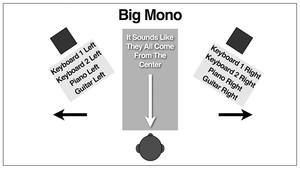- in Book Excerpt , Production , Recording by Bobby Owsinski
How To Avoid “Big Mono” During Recording
 We all love big wide stereo soundfields, especially the ones that come from the stereo output of an electronic keyboard. If you pan too many elements hard left and hard right however, you end up with “Big Mono,” which is a term that my friend Ed Seay likes to use. That means that you actually lose the sense of stereo when so many elements are panned on top of one another. While using true stereo capture techniques during recording can provide some awesome ssoundfields, sometimes what you get out of an electronic keyboard can be less than satisfying. Here’s an excerpt from Chapter 11 of the 4th edition of my Recording Engineer’s Handbook that provides some alternate techniques for recording that will help you stay away from the dreaded Big Mono.
We all love big wide stereo soundfields, especially the ones that come from the stereo output of an electronic keyboard. If you pan too many elements hard left and hard right however, you end up with “Big Mono,” which is a term that my friend Ed Seay likes to use. That means that you actually lose the sense of stereo when so many elements are panned on top of one another. While using true stereo capture techniques during recording can provide some awesome ssoundfields, sometimes what you get out of an electronic keyboard can be less than satisfying. Here’s an excerpt from Chapter 11 of the 4th edition of my Recording Engineer’s Handbook that provides some alternate techniques for recording that will help you stay away from the dreaded Big Mono.
“Virtually all electric keyboards have a stereo output, but in the majority of cases the stereo is derived from taking a mono signal and blending it with an effect such as a chorus. While this can sound great on its own, adding a few layers of keyboards to a track can soon make this effect turn into something called Big Mono (see the graphic on the left).
The more keyboard layers that are added and the wider they’re panned, the more the individual parts blend together – more because of the effect used to stereoize them than anything else.
While this blending might work in some cases, in others you probably want to hear each of these parts distinctly from one another. There are three ways overcome Big Mono:
- Record the instrument in mono by not using the output that’s effected. You can stereoize it in the mix with effects that are more appropriate for the song.
- Some keyboards have mono samples just for recording, and these are the ones to use.
- A few keyboards that use samples have had their samples recorded in true stereo. Even if you use the stereo sample, try to pan it to a section of the stereo soundfield other than hard right and hard left.
TIP: If you must record in stereo with the effect, you can minimize the big-mono effect by making sure that no two instruments are panned on top of one another (such as hard left and hard right) and instead each stereo instrument is panned to its own space in the stereo spectrum.”
You can read more from The Recording Engineer’s Handbook and my other books on the excerpt section of bobbyowsinski.com.

